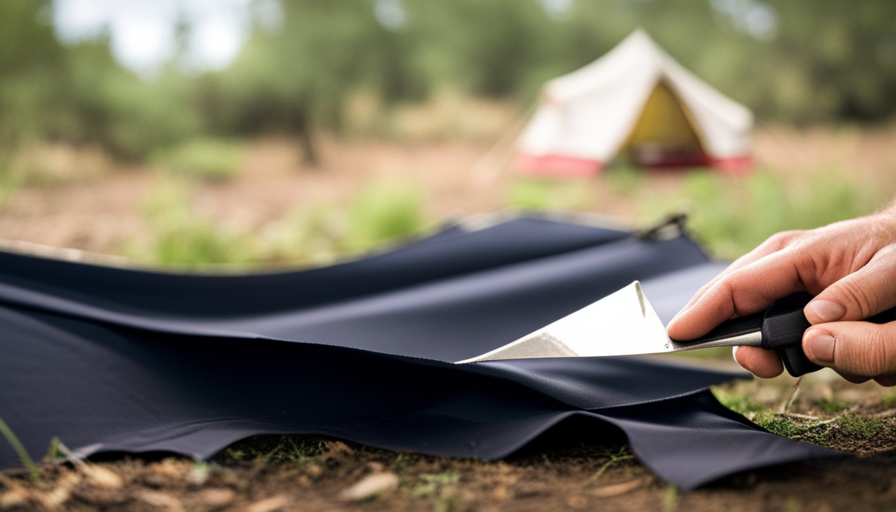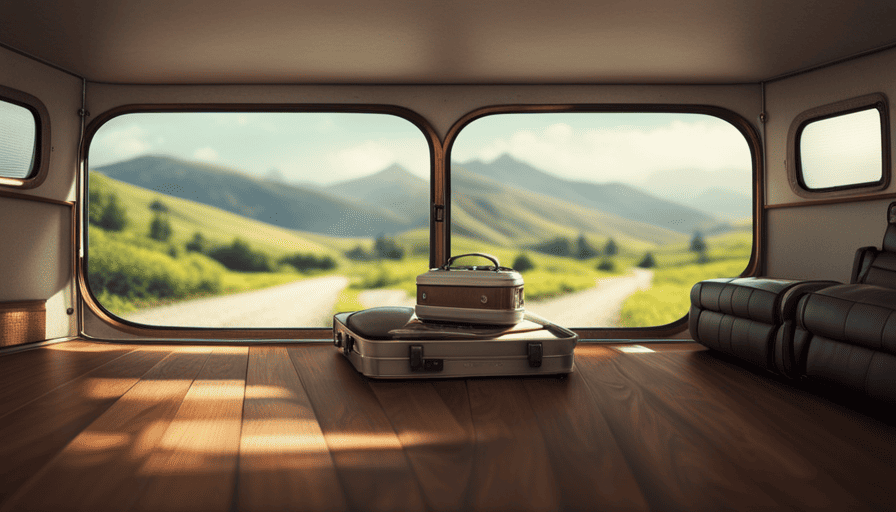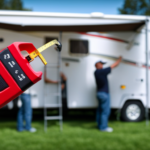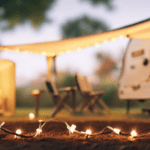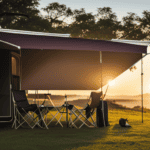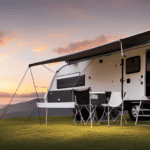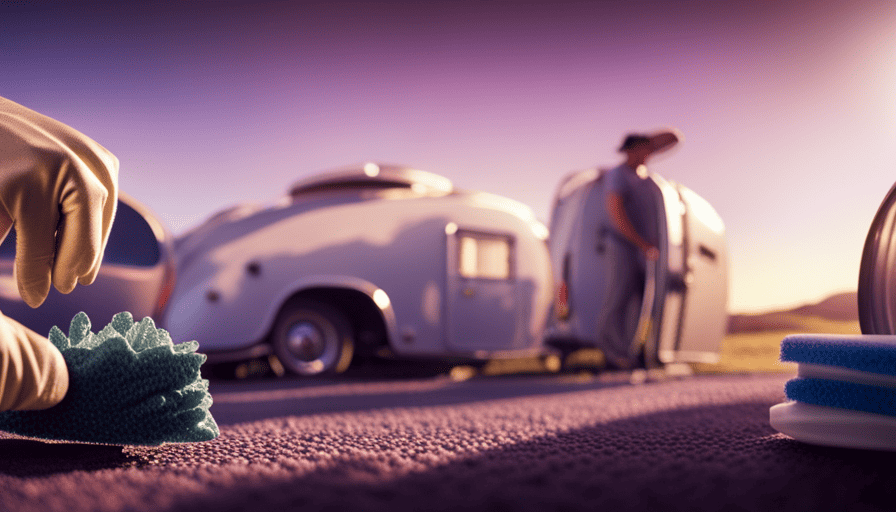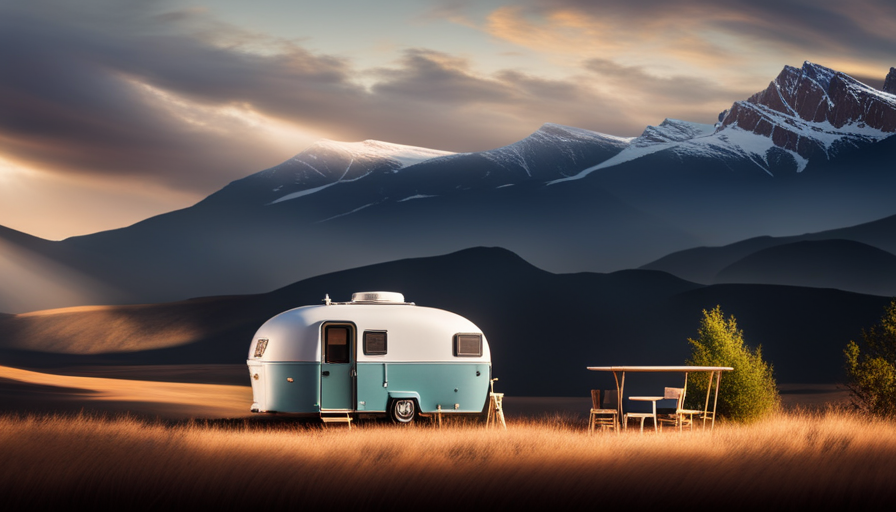You may be asking yourself, “Why bother making a camper awning from a tarp instead of buying one?” Let me clarify, there are many convincing reasons why investing time in creating your own camper awning is worthwhile.
Not only is it a cost-effective option, but it also allows you to customize the size, shape, and color to perfectly fit your needs and personal style. Plus, making your own awning gives you the satisfaction of knowing that you crafted something useful with your own two hands.
In this article, I will guide you through the step-by-step process of making a camper awning from a tarp. We will start by gathering the necessary materials and tools, then move on to measuring and cutting the tarp, reinforcing the edges, attaching grommets or eyelets, and installing awning poles or supports.
I will also provide tips for testing and adjusting the awning, adding additional features if desired, and maintaining and cleaning your awning for long-lasting use.
So, let’s get started and enjoy the great outdoors with your new homemade camper awning!
Key Takeaways
- Cost-effective option: making a camper awning from a tarp
- Customization of size, shape, and color when creating your own awning
- Reinforcing the edges increases durability and lifespan of the awning
- Choose awning poles made of aluminum, steel, or fiberglass
Gather Materials and Tools
Now that you’ve decided to create your own camper awning, it’s time to gather all the materials and tools you’ll need to bring your outdoor oasis to life.
The first step is to choose the right tarp for your awning. Look for a tarp that’s durable, waterproof, and has UV protection to ensure it can withstand different weather conditions. It’s also important to consider the size of the tarp and make sure it’ll provide enough coverage for your desired awning size.
If you’re feeling adventurous, you can also consider using alternative materials for your awning. Canvas is a popular choice as it’s sturdy and provides excellent protection from the elements. Another option is using a parachute fabric, which is lightweight and easy to pack. Whichever material you choose, make sure it’s suitable for outdoor use and can be easily attached to your camper.
Next, gather the necessary tools for the installation process. You’ll need a tape measure to determine the dimensions of your awning, as well as a marker to mark the areas where you’ll be cutting the tarp. Additionally, you’ll need a pair of sharp scissors or a utility knife to cut the tarp to the desired size.
Now that you have all the materials and tools ready, it’s time to move on to the next step: measuring and cutting the tarp.
Measure and Cut the Tarp
First, grab your trusty measuring tape and accurately size up the tarp, just like a tailor expertly taking measurements for a bespoke suit. Measuring techniques are crucial in ensuring that your camper awning fits perfectly and provides optimal coverage.
Start by laying out the tarp on a flat surface and straightening it out. Use the measuring tape to determine the desired length and width of your awning. Remember to account for any additional overhang you want to create. Once you have the measurements, mark them with a pen or chalk on the tarp. To ensure accuracy, it’s helpful to have someone assist you in holding the tape and keeping it taut while you mark the measurements.
Next, it’s time to cut the tarp. Use a sharp pair of scissors or a utility knife to carefully cut along the marked lines. Take your time and make clean, straight cuts to ensure a professional-looking finish.
Once you have finished cutting the tarp, you can move on to reinforcing the edges, which will be discussed in the next section about reinforcing the edges.
Reinforce the Edges
To ensure durability and longevity, reinforcing the edges of your awning is essential. By reinforcing the edges, you can prevent fraying and tearing, allowing your awning to withstand the elements and prolong its lifespan. There are several reinforcing techniques you can use, such as folding and sewing the edges, or using binding tape or webbing.
One popular method is to fold the edges over and sew them, creating a double-layered edge that is stronger and less likely to fray. Another option is to use binding tape or webbing, which can be sewn onto the edges of the tarp to provide extra reinforcement. Whichever method you choose, make sure to use a strong thread and sew with a tight, zigzag stitch to ensure maximum strength.
By reinforcing the edges of your camper awning, you can enjoy several benefits. Firstly, it will prevent the tarp from fraying or tearing, which can compromise its ability to provide shade and protection. Additionally, a reinforced edge will make the awning more durable, allowing it to withstand strong winds and other weather conditions. This means that your awning will last longer and provide you with many seasons of enjoyment.
Now that you have reinforced the edges of your awning, it’s time to move on to the next step: attaching grommets or eyelets.
Attach Grommets or Eyelets
Secure your awning by attaching grommets or eyelets, ensuring a sturdy and reliable fastening method for your outdoor shade.
When it comes to attaching grommets or eyelets to your tarp, there are a few different types of materials you can use. One option is to use metal grommets, which are durable and long-lasting. Another option is to use plastic eyelets, which are lightweight and easy to install. Additionally, you can also use fabric loops or reinforced corners to attach the grommets or eyelets.
To properly attach grommets or eyelets to your tarp, there are a few tips and tricks you should keep in mind. First, make sure to reinforce the area where you will be attaching the grommets or eyelets by sewing an extra layer of fabric or using adhesive tape. This will help prevent the grommets or eyelets from tearing out under tension.
Second, use a grommet tool or eyelet punch to create the holes in the tarp. This will ensure clean and precise holes for the grommets or eyelets.
Finally, follow the manufacturer’s instructions for attaching the grommets or eyelets, as different types may require different installation methods.
With your grommets or eyelets securely attached, you’re now ready to move on to the next step of installing awning poles or supports.
Install Awning Poles or Supports
Now that you’ve got your grommets or eyelets securely in place, it’s time to bring your outdoor shade to life by installing the sturdy and supportive awning poles or supports. This will give your space a sense of strength and stability. Installing awning fabric requires the right choice of awning poles to ensure proper installation and functionality.
First, you need to decide on the type of awning poles that’ll work best for your camper. There are various options available, including aluminum, steel, and fiberglass poles. Consider factors such as durability, weight, and ease of setup when making your decision. Aluminum poles are lightweight and resistant to corrosion, making them a popular choice among campers.
Once you’ve chosen the right awning poles, it’s time to install them. Start by extending the poles and connecting them securely to the grommets or eyelets on your tarp. Make sure they’re firmly in place and provide enough support to withstand wind and other weather conditions.
With the awning poles in place, you can now transition into the next step of securing the awning to your camper.
Secure the Awning to Your Camper
Once the sturdy and supportive awning poles are in place, you can seamlessly attach the outdoor shade to your camper, creating a cozy and inviting space for relaxation and enjoyment. Anchoring options for camper awnings are crucial to ensure that your awning stays securely attached, even in windy conditions. There are various types of awning attachments for campers, each with its own advantages and considerations.
To provide a visual representation of these options, consider the following table:
| Attachment Type | Description | Pros | Cons |
|---|---|---|---|
| Rope and Stake | Secures the awning using ropes and stakes | Easy to set up and adjust | Less stable in strong winds |
| Clamp | Uses clamps to attach the awning to the camper | Provides a secure attachment point | May require drilling into the camper |
| Suction Cup | Relies on suction cups to hold the awning in place | No need for drilling or permanent attachment | Less reliable in extreme weather conditions |
| Velcro | Utilizes Velcro strips to fasten the awning to the camper | Quick and easy to attach and detach | May lose grip over time, especially in hot temperatures |
Once you have secured the awning to your camper using your preferred attachment method, you can proceed to the next step of testing and adjusting the awning to ensure optimal coverage and stability.
Test and Adjust the Awning
Take a moment to step back and marvel at the shade and comfort your new awning brings to your outdoor space. Now that you’ve securely attached the awning to your camper, it’s time to test and adjust it to ensure it’s functioning properly.
Start by extending the awning fully and checking for any signs of strain or sagging. If you notice any, adjust the tension knobs or straps accordingly to achieve a balanced and stable setup.
Next, test the retracting mechanism by carefully rolling up the awning. Make sure it rolls up smoothly and evenly without any obstructions or resistance. If you encounter any issues, such as the awning getting stuck or not rolling up tightly enough, refer to the manufacturer’s instructions for troubleshooting tips or contact their customer support for assistance.
To fix common issues with camper awnings, such as loose fabric or uneven tension, start by inspecting the awning arms and support poles for any loose or missing screws. Tighten or replace them as necessary. Additionally, if the fabric is sagging or not taut enough, adjust the tension knobs or straps on the arms to achieve the desired tightness.
In the next section, we’ll explore how to add additional features to your camper awning to enhance its functionality and make your outdoor experience even more enjoyable.
Add Additional Features (Optional)
Enhance your outdoor oasis by exploring exciting extras for your camper canopy. Once you’ve set up your basic awning, you can consider adding additional features to make it even more functional and comfortable.
One popular addition is attaching a mesh screen to your awning to keep bugs out while still enjoying the fresh air. You can easily accomplish this by sewing or using adhesive tape to attach the screen to the edges of your tarp.
Another option is to install a set of LED lights along the edges of the awning, providing a cozy ambiance for evening gatherings.
If you want to create a more private space, consider adding side walls to your canopy. These can be made from the same tarp material or a different fabric, depending on your desired level of privacy. You can attach these walls using hooks, Velcro, or even magnets for easy installation and removal.
By adding these additional features, you can customize your camper awning to meet your unique needs and create a comfortable outdoor living space.
Now that you’ve enhanced your awning, it’s important to maintain and clean it regularly to ensure its longevity and functionality.
Maintain and Clean Your Awning
To keep your outdoor oasis looking its best, it’s crucial to regularly maintain and clean your canopy. Proper awning maintenance will help prolong its lifespan and ensure it continues to provide shade and protection for your camper. Start by inspecting the awning for any signs of wear or damage, such as tears or loose stitching. Repair any issues promptly to prevent further damage. Additionally, regularly clean your awning to remove dirt, debris, and mildew. Use a soft brush or sponge and a mild soap solution to gently scrub the fabric. Rinse thoroughly and allow it to dry completely before retracting or storing the awning. It’s important to avoid using harsh chemicals or abrasive cleaning tools, as they can damage the fabric.
Incorporating regular maintenance and cleaning into your routine will help extend the life of your camper awning and keep it looking great throughout your outdoor adventures. Now, it’s time to enjoy your outdoor adventures with your new camper awning!
Enjoy Your Outdoor Adventures with Your New Camper Awning!
Get ready to bask in the shade and soak up the outdoor experience with your new camper awning – it’s like having a cozy tree canopy wherever you go!
Now that you have your camper awning set up and ready to go, it’s time to enjoy your outdoor adventures to the fullest.
One of the best parts of camping is cooking over a campfire, and with your camper awning, you can create the perfect outdoor kitchen. Set up a portable grill or bring along a cast iron skillet for some delicious campfire cooking. Don’t forget to pack some essential campfire cooking tools like long-handled tongs and a sturdy spatula. With the shade provided by your awning, you can cook comfortably even on hot summer days.
When it comes to choosing camping spots in the US, the options are endless. From national parks to hidden gems, there’s something for everyone. Some of the best camping spots in the US include Yosemite National Park in California, Glacier National Park in Montana, and the Great Smoky Mountains in Tennessee. Each of these locations offers breathtaking views, hiking trails, and opportunities for outdoor activities.
So, grab your camping gear, pack your favorite recipes, and hit the road with your new camper awning. With the shade and comfort it provides, along with the best camping spots in the US, you’re sure to have an unforgettable outdoor adventure. Happy camping!
Frequently Asked Questions
How do I choose the right size tarp for my camper awning?
When choosing the right size tarp for your camper awning, there are a few factors to consider.
Firstly, think about the dimensions of your camper and how much coverage you need. Measure the length and width of your desired awning area and choose a tarp that matches those measurements.
Secondly, consider the color and tarp thickness. Opt for a color that complements your camper’s aesthetic and select a thickness that provides adequate protection against the elements.
Can I use a tarp made of a different material for my camper awning?
Yes, you can use a tarp made of a different material for your camper awning. There are various options available, each with its own pros and cons.
For example, canvas tarps are durable and provide excellent protection against the elements, but they can be heavy and more expensive. Alternatively, you could consider using a polyester or vinyl tarp, which are lightweight, affordable, and offer good water resistance.
Additionally, there are alternatives to tarps for camper awnings, such as retractable awnings or shade sails.
How do I know where to attach the grommets or eyelets on my tarp?
To determine where to attach the grommets or eyelets on your tarp, there are a few factors to consider. First, measure the area you want to cover and add a few extra inches for overhang. Next, think about the intended use and weather conditions you’ll encounter.
For attaching the grommets or eyelets, follow these steps:
1) Mark the desired locations evenly along the edges of the tarp.nn2) Use a grommet tool or eyelet kit to create the holes.nn3) Insert the grommets or eyelets and secure them tightly.
What type of poles or supports should I use for my camper awning?
When it comes to choosing pole alternatives for your DIY awning supports, the options are endless. You have the freedom to get creative, from sturdy tree branches to telescopic tent poles. Just make sure the poles are strong enough to withstand the weight of the tarp and any potential wind. Additionally, consider using adjustable poles or supports with adjustable heights to ensure your awning is versatile and adaptable to different camping situations.
How do I clean and maintain my camper awning to ensure longevity?
Cleaning and maintaining your camper awning is essential for its longevity. To keep it in good condition, follow these cleaning tips and maintenance checklist.
Start by gently brushing off any loose dirt or debris. Then, mix a mild detergent with water and scrub the awning using a soft brush. Rinse thoroughly and allow it to air dry.
Regularly inspect for any tears or damage and repair them promptly. Additionally, consider applying a protective coating to enhance its durability.
Can I Use a Camper Awning on a Bicycle Camper?
When it comes to exploring the outdoors, versatility is key. So, can you make your own bicycle camper and use a camper awning? Absolutely! A camper awning can provide some much-needed shade and protection from the elements while you’re on the go with your bicycle camper. With some creativity and resourcefulness, you can enjoy the benefits of a camper awning on your two-wheeled adventure.
Conclusion
So there you have it, you’ve got your very own camper awning made from a simple tarp. It may take a bit of time and effort, but the end result is definitely worth it. As they say, "A little preparation goes a long way." With your new awning, you’ll be ready for any outdoor adventure that comes your way.
Whether it’s providing shade on a sunny day or shelter during a sudden rainstorm, your awning will be a practical addition to your camper. So go ahead, take on the challenge, and enjoy the great outdoors with your new camper awning!

